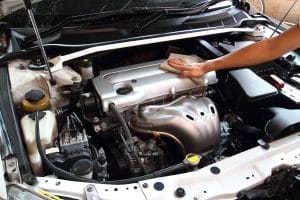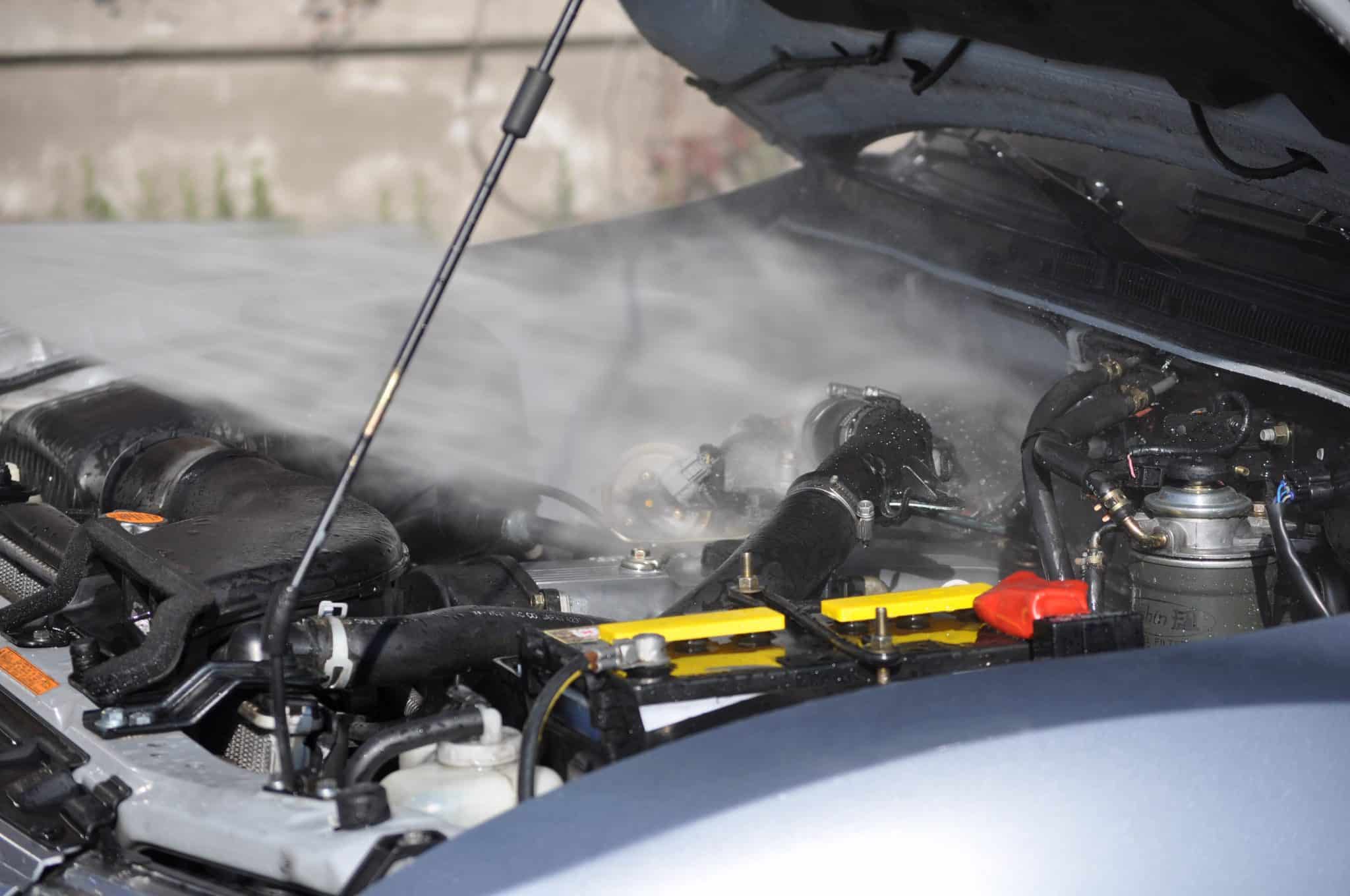
Car engine cleaning tips are important for many reasons. A clean engine runs cooler and helps improve fuel efficiency. It also prolongs the life of your engine. So cleaning the engine properly requires the best practices available.
A Clean Engine will Increase a Vehicle’s Resale Value
Another benefit is when you sell or trade-in a vehicle. A clean engine will increase resale values. This is why car dealers always have their vehicles fully detailed with shiny engines.
Unfortunately, since there are many ways that an engine can be damaged, you need to make sure you follow the procedures.
A Heated Pressure Washer is Preferable
Car engine cleaning is easier when you have the correct chemicals and equipment to do it. A heated pressure washer (aka steam jenny or hot water pressure washer) is preferable but not a necessity to properly clean an engine.
With a heated pressure washer or a steam pressure generator you can use less chemical and degrease the engine faster.
Cold Water Works Too
If you don’t have access to heat, cold water works too. FYI, it is possible to clean an engine without a pressure washer. The trick is to focus on the chemicals and attempt to use the least amount of water as possible.
PRO TIP: A hose from your home will generally push out water flow at approximately 5 to 10 GPM (gallons per minute) at 30 to 50 PSI (pounds per square inch). Most light-duty pressure washers, the kind you buy at any of the big box stores, will pump out 1.5 to 1.7 GPM at 1750 to 1850 PSI. Engines and water don’t work well together. Your goal is to clean the engine with the least amount of water possible. It makes sense to rely on chemical degreasers and a pressure washer with high PSI but low GPM output.
As mentioned above, blasting a bunch of water on your engine for the length of time required to clean it is a bad idea. This is why pressure washers are a detailer’s friend.

When Cleaning an Engine, Less is More
I have already mentioned this a few times, but I’m going to repeat it, yet again. With regards to water and engine cleaning, pressure (PSI) is good as long as gallons (GPM) is low.
Forcing water into an engine is something you don’t want to deal with. Especially since it’s probably a customer vehicle. So use less water and more pressure. And rely on the cleaning chemicals. Let the chemicals and degreaser do the work for you. Anywhere from 1,000 PSI on up to 2,000 PSI is more than sufficient when used with lower GPM and degreasers. Any more than that and you run the risk of injecting water into places you don’t want water in your engine.
Engine Running or Not?
This topic alone could fill several blog posts. For now, let’s just say that the great debate among car detailers for many decades has been whether to keep a car engine running while cleaning it. This is one of those areas that we need to add our standard disclaimer about how we take no responsibility for any damage that you do to an engine. We can only tell you how we’ve done this and you use this information at your own risk.
PRO TIP: If you want to get better at anything, practice. A few years after I started my detail shop, I was always trying to give my new detailers more hands-on experience. Unfortunately, when you put a new detailer on a customer car, you run the risk of something being damaged. So I bought a clunker. See the ‘Shop Dart’ section below to learn more about our lovely practice car.
We Started Out Leaving the Engine Running
At our shops, our process changed over the years. At first, we started out leaving the engine running. I ran the car engine for about 15 minutes to warm it up. Then I would cover up air intakes, electrical boxes, wiring harnesses, and spark plugs.
A generous amount of cleaner/degreaser solution was applied and allowed to soak for 15 to 20 minutes. After the soak, the engine was started. A heated pressure washer on the high heat/steam setting is used to spray the engine clean. We never had an issue with any of the thousands of cars that were cleaning in this way.
Process Changed as Degreasers Got Stronger
Even in industries as slow-moving and stale as auto detailing, car chemical companies still attempt to make better products. This is what happened that caused me to rethink our engine cleaning process. I started noticing that the degreasers we were buying were showing improved results over the course of a few years. Our engine cleaning process changed as degreasers improved. It made sense since we no longer had to apply so much water and steam to engines to clean them. We were still careful to cover delicate electronics and wiring harnesses, but we were able to use a lot less water.
Your car engine cleaning chemicals make a world of difference. Don’t just buy a cheap degreaser. If you are doing this professionally, then set yourself apart from every Joe Schmo who can buy cheap cleaners for their engines and do it at home.
The Shop Dart
A friend of mine asked if I knew anyone that wanted an extremely old Dodge Dart with a few hundred thousand miles on it. I asked him how much. He said a few hundred bucks. So I gave him $300 and became the proud owner of an incredibly ugly Dart. We eventually named her our ‘Shop Dart’.
Car Engine Cleaning is a Skill
Over the next few years, our team high speed buffed the paint straight down to the metal. We removed dents, did bumper repairs, and scratch removal. And the car was painted and repainted so many times that none of us could remember the original color. All the upholstery was ripped and repaired hundreds of times. Two of my guys even wanted to learn how to rewire a car. So they practiced on the Dart.
Like anything, car engine cleaning is a skill. And skills need to be learned through practice. Our Shop Dart had an engine that was cleaned so often, it shined like it was in a classic car cruise.
If you want to get better, it’s all about practice. If you want to know what happens when you fill fuel injectors with water, then do it on purpose to your junker car. Then learn how to fix it.
Curious about what happened to the infamous Dodge Dart? There’s a cool story about it. My team tore down and rebuilt that car so many times that it looked better than it did when it was brand new. Then one day, my shop manager asked if we could get a few different clunker cars to practice on. I told him we could look around and find some.
Then I had a somewhat brilliant idea. During our morning meeting the next day, I announced that we could put the Shop Dart out in front of our building and sell it. And if the guys wanted to make it perfect, they could all split whatever we sold it for between them. So they repainted it, again, made sure it was running perfect, and detailed it like it was a Lamborghini. It was fantastic.
Then we sold the Shop Dart… for $5 grand. No kidding. $5 thousand dollars. It looked amazing and it ran great. The guy that bought it loved the look. And my team was beyond excited when I handed them the money.
So that’s how we got great at detailing, reconditioning, and cleaning car engines. Hands-on practicing every day on an old clunker car.
We can only tell you how we did it for years and you decide how to proceed from there.
Have fun and enjoy the process. You shouldn’t have any problems as long as you follow the tips outlined above and use common sense along with a good safety regimen.
We hope you enjoyed this how-to on Car Engine Cleaning Tips. Access more tips, training, and insight by subscribing to the AutoDetailGuide.com E-Newsletter.
Suggested Pages to Check Out
Detail Shop Liability Insurance Page with Info on Garage Keepers Liability Coverage

